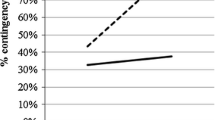Abstract
In order to describe and analyze teachers’ orchestrating of classroom discourse, detailed descriptions of teachers’ comments and questions are critical. The purpose of this article is to suggest new concepts that enable us to describe in detail how teachers use or do not use students’ comments to work with the mathematical content. Five teachers from upper primary school (grades five to seven, students aged 10 to 13) were studied. Beginning with the analysis of a pattern where the teacher gives a confirmation followed by a question that indicates a rejection, their practices form the basis for the development of 13 categories of teacher comments. These categories are then grouped into redirecting, progressing, and focusing actions. The categories and their groupings shed light on tools and techniques which these teachers use to make student strategies visible, to make students justify, apply and assess, to ensure progress towards a conclusion, or to redirect the students into alternative approaches. These findings can help us develop in the direction of a more profound understanding of how communication affects learning.


Similar content being viewed by others
References
Alrø, H., & Skovsmose, O. (2002). Dialogue and learning in mathematics education: Intention, reflection, critique. Dordrecht: Kluwer.
Ball, D. L. (2001). Teaching, with respect to mathematics and students. In T. L. Wood, B. S. Nelson, & J. Warfield (Eds.), Beyond classical pedagogy: Teaching elementary school mathematics (pp. 11–22). Mahwah, NJ: Erlbaum.
Brendefur, J., & Frykholm, J. (2000). Promoting mathematical communication in the classroom: two preservice teachers’ conceptions and practices. Journal of Mathematics Teacher Education, 3(2), 125–153. doi:10.1023/a:1009947032694.
Brousseau, G., & Balacheff, N. (1997). Theory of didactical situations in mathematics. Dordrecht: Kluwer.
Carpenter, T. P., Fennema, E., Franke, M. L., Levi, L., & Empson, S. B. (1999). Children’s mathematics: Cognitively guided instruction. Portsmouth, NH: Heinemann.
Cazden, C. B. (2001). Classroom discourse: The language of teaching and learning. Portsmouth: Heinemann.
Cengiz, N., Kline, K., & Grant, T. (2011). Extending students’ mathematical thinking during whole-group discussions. Journal of Mathematics Teacher Education, 15(5), 1–20. doi:10.1007/s10857-011-9179-7.
Drageset, O. G. (2009). Exploring mathematical knowledge for teaching. In M. Tzekaki, M. Kaldrimidou, C. Sakonidis (Eds.), Proceedings of the 33rd Conference of the International Group for the Psychology of Mathematical Education (vol. 2, pp. 473–480).
Drageset, O. G. (2010). The interplay between the beliefs and the knowledge of mathematics teachers. Mathematics Teacher Education and Development Journal, 12(1), 30–49.
Fraivillig, J. L., Murphy, L. A., & Fuson, K. C. (1999). Advancing children’s mathematical thinking in everyday mathematics classrooms. Journal for Research in Mathematics Education, 30(2), 148.
Franke, M.L., Kazemi, E., & Battey, D. (2007). Mathematics teaching and classroom practice. In F. K. Lester (Ed.), Second handbook of research on mathematics teaching and learning (pp. 225–256). NCTM.
Hutchby, I., & Wooffitt, R. (1998). Conversation analysis: Principles, practices and applications. Cambridge: Polity.
Kieran, C. (2002). The mathematical discourse of 13 year old partnered problem solving and its relation to the mathematics that emerges. In C. Kieran, E. A. Forman, & A. Sfard (Eds.), Learning discourse: Discursive approaches to research in mathematics education. Dordrecht: Kluwer.
Linell, P. (1998). Approaching dialogue. Talk, interaction and contexts in dialogical perspectives. Amsterdam: Benjamins.
Lithner, J. (2008). A research framework for creative and imitative reasoning. Educational Studies in Mathematics, 67(3), 255–276.
Mercer, N., & Littleton, K. (2007). Dialogue and the development of children’s thinking: A sociocultural approach. London: Routledge.
Mercer, N., & Sams, C. (2006). Teaching Children How to Use Language to Solve Maths Problems. Language and Education, 20(6), 507–528. doi:10.2167/le678.0
Mortimer, E. F., & Scott, P. (2003). Meaning making in secondary science classrooms. Buckingham: Open University Press.
NCTM. (1989). Curriculum and evaluation standards for school mathematics. Reston, VA: National Council of Teachers of Mathematics.
Newman, D. (1990). Cognition, computing, and cooperation. In S. P. Robertson, W. Zachary, & J. B. Black (Eds.), Cognition, computing, and cooperation (pp. 84–94). Norwood, NJ: Ablex.
Niss, M., & Højgaard Jensen, T. (2002). Kompetencer og matematiklæring: Ideer og inspiration til udvikling af matematikundervisning i Danmark [Competencies and mathematics learning: ideas and inspiration for development of mathematics teaching in Denmark]. København: Undervisningsministeriet.
Sacks, H., Schegloff, E. A., & Jefferson, G. (1974). A simplest systematics for the organization of turn-taking for conversation. Language, 50(4), 696–735.
Sidnell, J. (2010). Conversation analysis. An introduction. Chichester: Wiley-Blackwell.
Stein, M. K., Engle, R. A., Smith, M. S., & Hughes, E. K. (2008). Orchestrating productive mathematical discussions: five practices for helping teachers move beyond show and tell. Mathematical Thinking and Learning, 10(4), 313–340.
Vygotsky, L. S. (1978). In M. Cole, V. John-Steiner, S. Scribner, & E. Souberman (Eds.), Mind in society: The development of higher psychological processes. Cambridge, MA: Harvard University Press.
Wells, G. (1993). Reevaluating the IRF sequence: A proposal for the articulation of theories of activity and discourse for the analysis of teaching and learning in the classroom. Linguistics and Education, 5(1), 1–37.
Wood, T. (1998). Alternative patterns of communication in mathematics classes: Funneling or focusing? In H. Steinbring, M. G. Bartolini Bussi, & A. Sierpinska (Eds.), Language and communication in the mathematics classroom (pp. 167–178). Reston, VA: National Council of Teachers of Mathematics.
Wood, T., Williams, G., & McNeal, B. (2006). Children’s mathematical thinking in different classroom cultures. Journal for Research in Mathematics Education, 37(3), 222–255.
Author information
Authors and Affiliations
Corresponding author
Rights and permissions
About this article
Cite this article
Drageset, O.G. Redirecting, progressing, and focusing actions—a framework for describing how teachers use students’ comments to work with mathematics. Educ Stud Math 85, 281–304 (2014). https://doi.org/10.1007/s10649-013-9515-1
Published:
Issue Date:
DOI: https://doi.org/10.1007/s10649-013-9515-1




